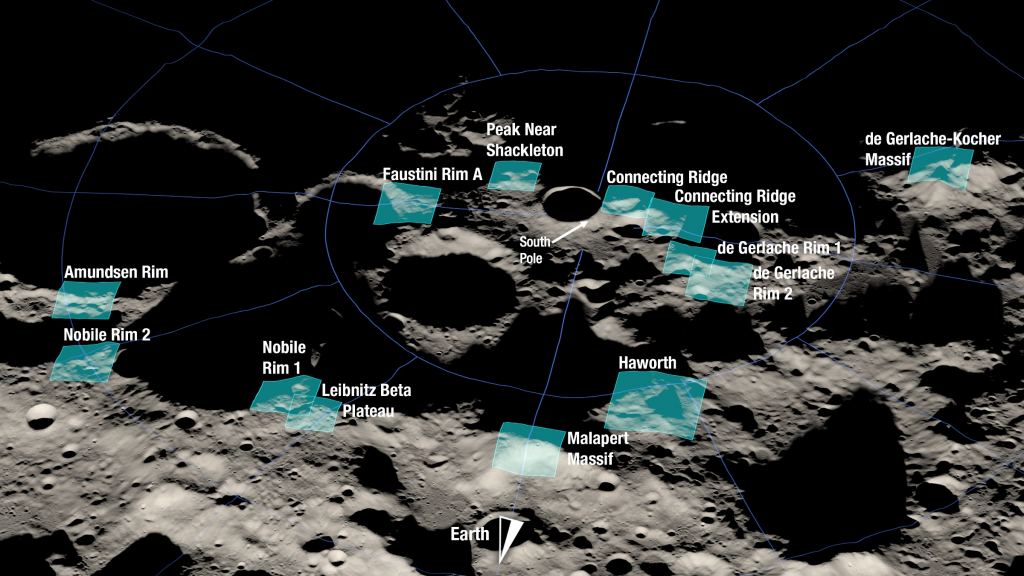In just four days, the inaugural mission of the Artemis Program will lift off from Kennedy Space Center in Florida! Dubbed Artemis I, this mission will see the Space Launch System (SLS) and Orion spacecraft achieve flight together for the first time. The mission will last between 39 and 42 days and consist of the uncrewed Orion flying beyond the Moon, farther than any spaceship has ever traveled, and then looping back around the Moon to return home. This flight, and the crewed Artemis II that will follow, are essentially the dress rehearsal for the long-awaited return to the Moon.
Designated Artemis III, this mission is scheduled to take place in 2025 and will see the “first woman and first person of color” set foot on the lunar surface. It will also be the first time in over 50 years (since Apollo 17 landed in 1972) that astronauts will venture beyond Low Earth Orbit (LEO). In preparation for this, NASA has identified 13 candidate regions in the Moon’s South Pole-Aitken Basin, which they recently shared with the public.
Each region contains multiple potential sites where the Starship Human Landing System (HLS) will land. NASA identified the following candidate regions for an Artemis III lunar landing: Faustini Rim APeak Near ShackletonConnecting RidgeConnecting Ridge Extensionde Gerlache Rim 1de Gerlache Rim 2de Gerlache-Kocher MassifHaworthMalapert MassifLeibnitz Beta PlateauNobile Rim 1Nobile Rim 2Amundsen Rim Each region is approximately 15 square kilometers (9. 3 mi2), and the landing sites located within them occupy an approximately 100-meter (~106-yard) radius.
These regions are all located within 6° latitude of the lunar South Pole because of the many permanently-shadowed craters that cover the landscape. This allows for there to be abundant water ice and other resources around the south pole. In addition, the region contains some of the Moon’s most ancient terrain that humans have yet to explore.
Sarah Noble, the Artemis lunar science lead for NASA’s Planetary Science Division, explained in a recent NASA press release: “Several of the proposed sites within the regions are located among some of the oldest parts of the Moon, and together with the permanently shadowed regions, provide the opportunity to learn about the history of the Moon through previously unstudied lunar materials,” These regions were selected by an agency-wide team of scientists and engineers who assessed the lunar South Pole using data from NASA’s Lunar Reconnaissance Orbiter (LRO) and other missions, as well as decades’ worth of studies and lunar science. The team then evaluated each region based on launch window availability and potential for accommodating a safe landing (based on terrain slope, ease of communications with Earth, and lighting conditions). They also considered the regions’ accessibility based on the combined capabilities of the SLS, Orion, and the Starship HLS.
A conceptual plan of how HLS will be utilized. Credit: Chojnacki/NASA Having multiple regions with multiple landing sites ensures flexibility to launch throughout the year. The analysis team also weighed other criteria specific to the Artemis III mission’s science objectives, such as landing close enough to a permanently shadowed region (without disturbing it) and allowing the crew to conduct extra-vehicular activities (EVAs) – aka.
“moonwalks. ” This will allow the crew to collect samples and perform scientific analysis in an undisturbed area, yielding important information about water ice’s depth, distribution, and composition in the craters. Said Mark Kirasich, deputy associate administrator for the Artemis Campaign Development Division at NASA Headquarters: “Selecting these regions means we are one giant leap closer to returning humans to the Moon for the first time since Apollo.
When we do, it will be unlike any mission that’s come before as astronauts venture into dark areas previously unexplored by humans and lay the groundwork for future long-term stays. ” The selection of sites near permanently shadowed regions also had to consider other lighting conditions. All 13 regions contain sites that provide continuous sunlight throughout the planned 6.
5 days that the crew will spend on the surface. Access to sunlight is critical for a long-term stay on the Moon because operations will rely on solar power and minimize temperature variations for the astronauts and their equipment. Said Jacob Bleacher, chief exploration scientist for NASA: “Developing a blueprint for exploring the solar system means learning how to use resources that are available to us while also preserving their scientific integrity.
Lunar water ice is valuable from a scientific perspective and also as a resource, because from it we can extract oxygen and hydrogen for life support systems and fuel. ” NASA will be hosting a series of conferences and workshops to get the scientific community’s input and discuss each region’s merits. The feedback from these sessions will inform the selection process and could lead to additional regions being added for consideration.
NASA will also keep working with SpaceX to assess the Starship HLS’s landing capabilities and factor that into the selection process. NASA will also narrow down the possibilities as they get a better idea of the target launch date, which will dictate transfer trajectories and surface conditions. Beyond sending astronauts to the Moon for the first time since the Apollo Era, the long-term goal of the Artemis Program is to establish infrastructure on the Moon – i.
e. , the Artemis Base Camp and the Lunar Gateway – that will lead to a “sustained program of lunar exploration. ” As soon as the Deep Space Transport (DST) is added, this infrastructure will allow crewed missions to travel to Mars in the coming decade – as illustrated in NASA’s “Moon to Mars” mission architecture.
All of this is set to take place once astronauts land on the Moon again in just three years (barring any significant delays)! Further Reading: NASA The post Here is Where Astronauts Might Land on the Moon appeared first on Universe Today. .
From: universetoday
URL: https://www.universetoday.com/157270/here-is-where-astronauts-might-land-on-the-moon/



